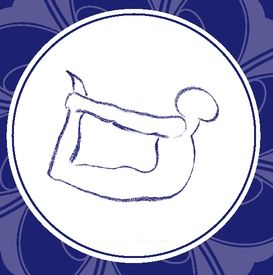dhanurasana
BOW POSE
Dhanurasana means “bow pose.” In this pose the body is bent backwards like an archer’s bow, with the torso and legs representing the body of the bow and the arms, the string. In addition to providing the general benefits of a backbend, such as creating openness in the upper spine and heart, this pose improves shoulder flexibility.
Finding the Right Effort
In dhanurasana the challenge is to find the right amount of extension in the pose. On a real bow, if the tension on the string is too great, it will break. And if there isn’t enough tension, the string will not have enough force to launch the arrow. The same principle applies for stringed instruments. To get the right tone, a musician must put the string under the right amount of tension. Finding our balance under just enough intensity, or bodily stress, in a pose is one of the key challenges in asana. This principle may also be applied to situations in our daily lives. The question is, how do we determine the right amount of effort when we’re in challenging situations?
Arjuna’s Dilemma
The great archer Arjuna once faced a terrible choice. War was imminent, and he knew that if he joined the battle, he would have to fight his own kinsmen. So he asked his friend and guide Krishna for counsel. Arjuna’s dilemma is immortalized in the great yogic scripture the Bhagavad Gita, or the “Song of Divinity,” divided into eighteen chapters that each cover a different aspect of yoga philosophy, and which has since become one of the most sacred and beloved texts on yoga. This text, which is contained within the larger Indian epic Mahabharata, is a dialogue between Arjuna, who represents our ego, and Krishna, who represents our higher consciousness. The text is a spiritual discourse that conveys practical yogic wisdom.
The Gita opens with Arjuna and Krishna standing on their chariot, overlooking the assembled armies. The approaching war is the last chance to reclaim a kingdom that was unjustly stolen from Arjuna and his brothers many years before. Faced with the prospect of having to fight and probably kill his own relatives and former teachers, Arjuna falters and lets his bow slip from his hands. He then puts his dilemma before Krishna, who functions as both his mentor and charioteer. What follows is a conversation captured in seven hundred Sanskrit verses.

Krishna starts by telling Arjuna he needs to fulfill his duty (known as dharma) as a warrior by fighting for a just cause against evil. Krishna then proceeds to teach Arjuna about the science of the soul, or yoga. He tells Arjuna that he need not worry about the deaths that will occur during the war, because no one in the world can kill the immortal soul. Fire cannot burn it and water cannot drown it. When the body is slain, the soul passes on to another body, just as we exchange old garments for a new set of clothes.
Krishna also advises Arjuna to accept both happiness and distress with detachment, because they come and go like the seasons and are merely sensory impressions. Many more profound teachings about and insights into the working of the mind and the forces of nature follow. The Gita ends with Krishna advising Arjuna to surrender himself to him, because Krishna is the personification of the Divine. This surrender is filled with love and support, and not at all like raising a white flag and giving up.
The teachings of the Gita are so vivid because Arjuna, with all of his doubt, is all too human. Life often presents difficult challenges, which sometimes make us want to give up rather than take appropriate action. In a sense we are all warriors, having to fight our way to enlightenment.
What the Bhagavad Gita does above all is place our life in a much larger context. Instead of being reactive when difficulties challenge our ego, we can learn, with the help of the Gita, to identify the ego and transcend it. We can start to look at obstacles in life as opportunities for personal growth, because we understand that there is a grand plan, of which each of us is a small yet essential part. The challenging bow pose creates an opportunity to apply the advice of the Gita in our asana practice: We try to strike that perfect balance of being fearless, taking responsibility for our life, and not giving in to difficulties, while at the same time staying detached from the results of our actions.


